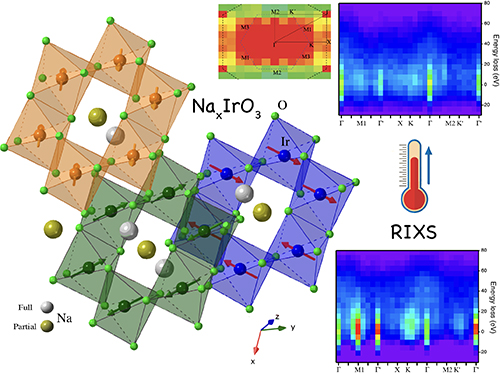
The future of computing is in quantum physics, which will enable computers to perform faster and far more complex calculations than are physically possible with our current silicon-based computers. But before such machines can become a practical reality, we need new materials beyond silicon with the exotic characteristics that can support quantum computing. One of the most highly sought types is the quantum spin liquid, in which long-range magnetic ordering is absent even at the lowest temperatures. Researchers employed high-brightness x-ray beams from the U.S. Department of Energy’s Advanced Photon Source (APS) to study the orbital and magnetic excitation spectra of one of the prime quantum spin liquid candidates, Na2IrO3, and its Na-deficient form, NaxIrO3. Their work appeared in Physical Review B.
Despite the term, a quantum spin liquid is not a conventional liquid such as water, but an exotic state of matter in which electron spins are always fluctuating, instead of lining up in a stable formation that permits magnetic order as in most conventional materials. The Na2IrO3 system is considered one of the best candidates for what's known as a Kitaev quantum spin liquid, in which the ground state of the material is a quantum spin liquid. Using resonant inelastic x-ray scattering measurements carried out at the X-ray Science Division Inelastic X-ray & Nuclear Resonant Scattering Group’s 27-ID beamline at the APS, a Department of Energy Office of Science user facility at Argonne National Laboratory, the investigators compared both Na2IrO3 and its Na-deficient form NaxIrO3 to elucidate the structural properties that frustrate magnetic order in the material.
As shown in Fig. 1, NaxIrO3 displays a layered honeycomb lattice structure with two-dimensional zigzag magnetic correlation at low temperature, similar to the three fluctuating zigzag magnetic orders seen in Na2IrO3. This two-dimensional zigzag magnetic pattern diminishes at higher temperatures to largely resemble a pure Kitaev model. The Na vacancy is located at the center of the honeycomb ring and appears to prevent long-range magnetic order by weakening exchange interactions. As shown by orbital excitation spectra, octahedral and trigonal crystal field splittings are larger in NaxIrO3 than in NaxIrO3, a result of shorter Ir-O bond lengths and larger trigonal distortion.
The lack of any long-range magnetic order above a temperature of 1 K in the NaxIrO3 material makes it an excellent candidate for a Kitaev quantum spin liquid. Further research will be needed to better define and confirm the observed properties of both of these materials and other prospective quantum spin liquids. Such work promises a greater understanding of the properties of quantum spin liquids that will point to efficient methods of synthesizing them and enhancing their properties for the many promising applications of quantum computing. ― Mark Wolverton
See: Jungho Kim1*, Hengdi Zhao2, and Gang Cao2, “Resolution of zigzag magnetic correlations in Na-deficient NaxIrO3 without long-range ordering,” Phys. Rev. B 106, 075157 (2022). DOI: 10.1103/PhysRevB.106.075157
Author affiliations: 1Argonne National Laboratory, 2University of Colorado at Boulder
Correspondence: * [email protected]
This work is supported by the National Science Foundation via Grant No. DMR 1903888. This research used resources of the Advanced Photon Source, a U.S. DOE Office of Science user facility operated for the DOE Office of Science by Argonne National Laboratory under Contract No. DE-AC02-06CH11357.
The U.S. Department of Energy's APS at Argonne National Laboratory is one of the world’s most productive x-ray light source facilities. Each year, the APS provides high-brightness x-ray beams to a diverse community of more than 5,000 researchers in materials science, chemistry, condensed matter physics, the life and environmental sciences, and applied research. Researchers using the APS produce over 2,000 publications each year detailing impactful discoveries, and solve more vital biological protein structures than users of any other x-ray light source research facility. APS x-rays are ideally suited for explorations of materials and biological structures; elemental distribution; chemical, magnetic, electronic states; and a wide range of technologically important engineering systems from batteries to fuel injector sprays, all of which are the foundations of our nation’s economic, technological, and physical well-being.
Argonne National Laboratory seeks solutions to pressing national problems in science and technology. The nation's first national laboratory, Argonne conducts leading-edge basic and applied scientific research in virtually every scientific discipline. Argonne researchers work closely with researchers from hundreds of companies, universities, and federal, state and municipal agencies to help them solve their specific problems, advance America's scientific leadership and prepare the nation for a better future. With employees from more than 60 nations, Argonne is managed by UChicago Argonne, LLC, for the U.S. DOE Office of Science.
The U.S. Department of Energy's Office of Science is the single largest supporter of basic research in the physical sciences in the United States and is working to address some of the most pressing challenges of our time. For more information, visit the Office of Science website.
